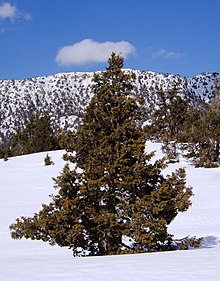Juniperus seravschanica
| Juniperus seravschanica | |
|---|---|

| |
| Scientific classification | |
| Kingdom: | Plantae |
| Clade: | Tracheophytes |
| Clade: | Gymnospermae |
| Division: | Pinophyta |
| Class: | Pinopsida |
| Order: | Cupressales
|
| Family: | Cupressaceae |
| Genus: | Juniperus |
| Section: | Juniperus sect. Sabina
|
| Species: | J. seravschanica
|
| Binomial name | |
| Juniperus seravschanica | |

| |
| Distribution of Juniperus excelsa complex | |
| Synonyms | |
| |
Juniperus seravschanica is a species of
It ranges from southernmost Kazakhstan through Kyrgyzstan, Tajikistan, eastern Uzbekistan and Turkmenistan, to northern and eastern Afghanistan, northern Pakistan, and Kashmir. Outlying populations are found in the mountains of southeastern Iran – near Kuhbanan, Rabor, and on Kuh-e Khabr in the Hazaran range – and the Hajar Mountains of Oman.[1][2]
Juniperus seravschanica is sometimes classified as a subspecies of J. polycarpos or J. excelsa.[1][2]
Distribution
Juniperus seravschanica occurs in the higher-elevation forests in
A substantial but dwindling forest of J. seravschanica is found in
The southernmost population of J. seravschanica is in the
Conservation
Overgrazing by camels, goats and feral donkeys has impeded regeneration of woodlands at altitudes below 2,400 m in Oman.[7]
References
- ^ a b "Juniperus seravschanica". Plants of the World Online. Accessed 5 December 2020. [1]
- ^ a b Adams, R.P., Al-Farsi, A. & Schwarzbach, A.E. (2014). Confirmation of the southern-most population of Juniperus seravschanica in Oman by DNA sequencing of nrDNA and four cpDNA regions Phytologia 96: 218-224.
- ^ "Gissaro-Alai open woodlands". Terrestrial Ecoregions. World Wildlife Fund.
- ^ "East Afghan montane coniferous forests". Terrestrial Ecoregions. World Wildlife Fund.
- ^ "Baluchistan xeric woodlands". Terrestrial Ecoregions. World Wildlife Fund.
- ^ "Pakistanpaedia - Forests of Pakistan (Juniper Forests)". pakistanpaedia.com.
- ^ a b "Al Hajar montane woodlands". Terrestrial Ecoregions. World Wildlife Fund.
